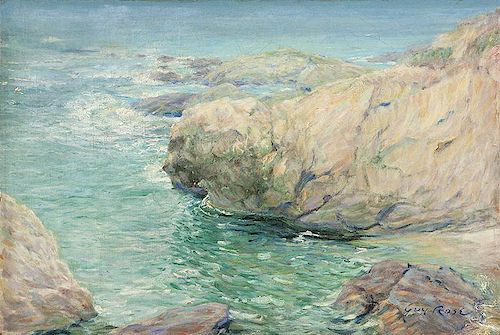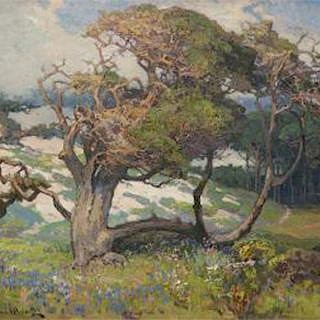Guy Rose (1867-1925 Pasadena, CA)
Lot 50
About Seller
John Moran Auctioneers
145 East Walnut Avenue
Monrovia, CA 91016
United States
John Moran Auctioneers is a family-owned and operated company, and market leader and trendsetter in sales of California and American art. We offer more works of California Impressionism, California Style watercolors, and Western art than any other auction house. Our personalized approach is our trad...Read more
Categories
Estimate:
$70,000 - $90,000
Absentee vs Live bid
Two ways to bid:
- Leave a max absentee bid and the platform will bid on your behalf up to your maximum bid during the live auction.
- Bid live during the auction and your bids will be submitted real-time to the auctioneer.
Bid Increments
| Price | Bid Increment |
|---|---|
| $0 | $25 |
| $500 | $50 |
| $1,000 | $100 |
| $2,000 | $250 |
| $5,000 | $500 |
| $10,000 | $1,000 |
| $20,000 | $2,500 |
| $50,000 | $5,000 |
| $100,000 | $10,000 |
| $200,000 | $25,000 |
| $500,000 | $50,000 |
| $1,000,000 | $100,000 |
About Auction
By John Moran Auctioneers
Mar 22, 2016 - Mar 23, 2016
Set Reminder
2016-03-22 22:00:00
2016-03-23 22:00:00
America/New_York
Bidsquare
Bidsquare : California & American Fine Art Auction
https://www.bidsquare.com/auctions/john-moran/california-american-fine-art-auction-1322
John Moran Auctioneers info@johnmoran.com
John Moran Auctioneers info@johnmoran.com
- Lot Description
''Monterey, Calif.'', a Monterey coastal landscape, circa 1918-1920, signed lower right: Guy Rose, titled on a gum label affixed to the stretcher, oil on canvas, 12'' H x 18'' W, est: $70,000/90,000 Note: When Guy Rose returned to his native Southern California in 1914 after eight years in Giverny, Northern France, he brought with him an intensified focus on light and atmosphere. Particularly in his Pacific seascapes, ''Rose could indulge two of his major pictorial interests explored at Giverny; reflections on water and multifarious atmosphere. It also satisfied his personal penchant for creating images of solitude and quiet'' (W. South, ''Guy Rose: American Impressionist''', Oakland, CA, 1995, p. 62). Rose first visited Carmel-by-the-Sea in 1918, and the Carmel and Monterey areas immediately became ''the primary focus of what were to be his last years of painting'' (W. South, p. 67). Rose spent the summers of 1918, 1919 and 1920 in Carmel and there produced a prodigious number of Carmel and Monterey coastals, exploring similar locations and views but always approaching each painting as a unique experience. ''It was clearly not Rose's intent to paint the same scene over and over, but rather to paint the varied experiences of expansiveness versus enclosure, of translucence versus opacity, or warmth versus cold'' (W. South, p. 67). ''Monterey, Calif.'' is a remarkable study of light and water-saturated air at the intersection where ocean meets land. Rose utilizes a restrained range from sunlight to shadow and plays with subtle changes in light and dark pigments to enliven the composition. ''Rose?s keen attentiveness to actual atmospheric conditions, derived most fully from Monet, intensifies the experience of openness and recession'' (W. South, p. 64). Recession is a prominent feature here as the exposed coastal rocks recede further and further into deepening water toward the open ocean. Interestingly, in the present work Rose omits the horizon line and sky, effectively reining in the sensation of an infinite sea often evoked by his coastals and directing attention instead toward rich coastal details. The immediacy of the foreground rocks along the lower compositional edge, painted in rose and blue-grey tones, give the impression that the viewer is in the scene, standing above the small cove. A glimpse of beach in the lower right nearly blends with the neighboring rocks, whose smooth planes become rough and craggy where the rock extends out and above the water. Spectral algae blooms on the underside reflect the water?s surface colors. The outcropping casts the deepest shadow in the composition, creating turquoise jewel-tone facets on the inside of a gentle wave moving toward the beach. The rich shadows are further emphasized by near-black paint used to present the rock below the shifting surface. Tight, lively brushstrokes of white water that churn over the edges of the retreating rocks in the middle ground are in contrast with elongated, flat, horizontal brushwork that finishes the furthest viewable ocean. Rose?s obsessive focus on color behavior in coastal atmospheric variation is on exquisite display in ''Monterey, Calif.'' . Provenance: The Baeder Estate, New YorkVisual: Generally good condition. Craquelure throughout. Blacklight: No evidence of restoration under blacklight.
Condition
- Shipping Info
-
The packing and handling of purchased lots by John Moran Auctioneer’s staff at the auction is undertaken solely as to customers. There is no charge for packing material and labor supplied to you on the evening of the sale. In no event will JMA be liable damage to painting, glass or frames regardless of cause in connection with this free service.JMA may, in our discretion and as a service to buyers, arrange to have purchased lots packed, insured and forwarded at the request, expense risk of the buyer. JMA assumes no responsibility for acts or omissions in such packing or shipping by other packers or carriers, whether recommended by JMA. Nor does JMA assume any responsibility for any damage to picture frames or to the glass therein. In circumstances JMA arranges and bills for such services via invoice or credit card, JMA will include an administration charge.In the case of JMA personally delivering an item, if an item cannot be delivered in condition equal to the existent condition at the time of should any item be mis delivered, stolen or lost prior to delivery, JMA‚s liability shall not exceed the amount paid by the buyer at the auction. Buyers are strongly encouraged to view all items auctioned on display before the auction to determine the true condition of items of interest.
-
- Buyer's Premium



 EUR
EUR CAD
CAD AUD
AUD GBP
GBP MXN
MXN HKD
HKD CNY
CNY MYR
MYR SEK
SEK SGD
SGD CHF
CHF THB
THB




















